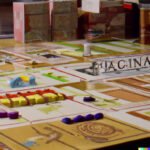Are you ready to take a trip down memory lane? The classic board games of the 90s hold a special place in many people’s hearts, evoking feelings of nostalgia and fond memories of game nights with friends and family. In this article, we will delve into the world of classic board games from the 90s, exploring their enduring appeal and cultural significance.
The 1990s was a decade that saw a shift in the world of board games. With the rise of technology and video games, traditional board games faced new challenges, yet managed to remain popular among audiences of all ages. From iconic games like Monopoly and Scrabble to lesser-known gems, the 90s had something for everyone when it came to board game entertainment.
In this exploration, we will take a closer look at how the 90s changed the game in terms of design, gameplay, and cultural impact. We will also analyze the enduring legacy of these classic board games and discuss their relevance in today’s modern era. Join us as we rediscover the joy and excitement brought by classic board games from the unforgettable decade of the 90s.
The Evolution of Board Games
The 1990s was a decade of significant change in the world of board games. With the rise of technology and changes in consumer trends, board games were forced to adapt and evolve in order to remain relevant.
This period marked a shift from traditional roll-and-move games to more strategic and immersive gameplay experiences. The evolution of board games in the 90s not only reflected the cultural and technological advancements of the time but also set the stage for the diverse range of board games we see today.
From Traditional to Trendsetting
In the 90s, board games underwent a transformation from simple, luck-based gameplay to more complex and strategic experiences. Games like Settlers of Catan and Magic: The Gathering revolutionized the industry by introducing new mechanics such as resource management, player interaction, and deck building. These innovative approaches to gameplay set a new standard for what board games could offer, paving the way for a wider variety of game genres and styles.
Pop Culture Influence
The 1990s saw a surge in pop culture references being incorporated into board games. With popular TV shows, movies, and video games influencing consumer preferences, board game manufacturers began creating licensed products based on iconic franchises.
This trend not only appealed to fans of these franchises but also brought new players into the world of board gaming. Games like Star Wars Monopoly and Pokémon Master Trainer capitalized on this trend, demonstrating how board games could tap into popular culture to stay relevant.
The 90s also saw an increase in storytelling and narrative-driven gameplay. Role-playing games (RPGs) like Dungeons & Dragons gained popularity during this time, allowing players to create their own adventures within a structured framework. This shift towards more immersive storytelling highlighted the potential for board games to provide unique and captivating experiences beyond traditional gameplay mechanics.
Iconic Games of the Decade
The 90s era was a golden age for classic board games, with an array of iconic and beloved titles that have left a lasting impact on pop culture. During this decade, families and friends bonded over games that have stood the test of time, becoming timeless favorites that are still enjoyed today. Let’s take a closer look at some of the most popular classic board games from the 90s and what made them so special.
The Game of Life
One of the quintessential board games of the 90s, The Game of Life simulated the journey from college to retirement with an exciting mix of chance and decision-making. Players spun a wheel to move through different stages of life, making choices that could lead to financial success or unexpected obstacles. The game’s lighthearted approach to adulting resonated with players and made it a staple in many households.
Clue
Mystery lovers were drawn to Clue, a thrilling whodunit game that required deductive reasoning and strategy to solve a murder mystery. With its suspenseful gameplay and cast of intriguing characters, Clue captivated players with its intricate storytelling and clever mechanics. The game remains an enduring classic that has spawned numerous adaptations in popular culture, including movies and television shows.
Monopoly
Arguably one of the most famous board games ever created, Monopoly dominated family game nights in the 90s with its competitive real estate gameplay. The game allowed players to buy, sell, and trade their way to riches while navigating economic challenges and rivalries. Its enduring popularity led to various themed editions based on pop culture franchises, ensuring its relevance among new generations.
These iconic board games defined an era where simple yet engaging gameplay brought people together for memorable experiences filled with laughter, competition, and fun. Their timeless appeal continues to resonate with both nostalgia seekers and new generations looking for classic gaming experiences.
Board Game Culture
The 90s were a time when board game culture experienced a resurgence, with game nights becoming a social phenomenon. Friends and family would gather to engage in friendly competition, forming bonds and creating lasting memories over classic board games. Some of the most popular games of the decade included:
- Monopoly: This timeless game of property trading and strategy was a staple at many 90s game nights.
- Scrabble: A word game that tested players’ vocabulary and strategic thinking, Scrabble was a favorite for those who enjoyed mental challenges.
- Trivial Pursuit: Testing players’ knowledge across various categories, Trivial Pursuit brought out the competitive spirit in many game night participants.
Game nights were not only about playing board games, but also provided an opportunity for social interaction and bonding. People would come together to relax, have fun, and enjoy each other’s company in an era before smartphones and digital distractions dominated social gatherings.
In addition to providing entertainment, board game culture of the 90s also played a significant role in enhancing communication skills and fostering teamwork among participants. It was not just about winning or losing, but about spending quality time with loved ones and strengthening interpersonal relationships through shared experiences.
The Technology Factor
The 1990s marked a significant shift in entertainment with the rise of video games. As technology advanced, more and more households invested in gaming consoles, leading to a decline in traditional board game sales. The convenience and allure of virtual gameplay posed a real threat to the classic board game industry.
During this time, many board game manufacturers had to adapt their marketing strategies to compete with the booming video game market. Some companies even incorporated elements of digital technology into their board games, introducing electronic versions and interactive components to appeal to a new generation of tech-savvy consumers.
To counteract the impact of video games on board game sales, some manufacturers focused on creating unique and immersive gaming experiences that couldn’t be replicated in virtual form. They emphasized the social interaction, strategic thinking, and face-to-face camaraderie that traditional board games provided, presenting them as an alternative to solitary screen time.
- Many board game manufacturers adapted marketing strategies
- Introduced electronic versions and interactive components
- Emphasized social interaction and face-to-face camaraderie
Ultimately, while video games did pose a challenge for classic board games during the 90s, the industry demonstrated resilience by evolving and finding ways to coexist alongside digital entertainment.
The Enduring Legacy
The classic board games of the 90s, such as Monopoly, Scrabble, and Trivial Pursuit, still hold a special place in the hearts of many people today. Despite the advancements in technology and the rise of video games, these timeless board games continue to be relevant and beloved by both older generations who grew up playing them and younger individuals who are discovering their charm for the first time.
One reason for the enduring legacy of classic board games from the 90s is their ability to bring people together. In a world dominated by screens and digital communication, sitting around a table with friends or family to play a board game provides valuable face-to-face interaction. The nostalgia associated with these games also adds to their appeal, as they evoke memories of simpler times and cherished moments from the past.
Furthermore, many classic board games from the 90s have adapted to modern times by creating digital versions or mobile apps, allowing new generations to experience these timeless favorites in a format that aligns with their tech-savvy preferences. This bridge between traditional gameplay and digital innovation ensures that classic board games remain accessible and appealing in today’s fast-paced world.
| Classic Board Games | Publishing Year |
|---|---|
| Monopoly | 1935 |
| Scrabble | 1948 |
| Trivial Pursuit | 1981 |
Collectors’ Corner
The 90s marked a golden era for classic board games, and many collectors are now seeking out these vintage games for their historical and nostalgic value. While some may view these games as mere playthings, there is a growing appreciation for the cultural significance and collectible nature of these artifacts. In fact, certain classic board games from the 90s have become valuable collector’s items, fetching high prices in the resale market.
One such highly sought after game is the first edition of “Settlers of Catan,” which was released in 1995. This German-style board game has gained a cult following over the years and has even spawned numerous expansions and spin-off products. A mint condition first edition copy of this game can easily sell for hundreds of dollars on online marketplaces.
Another prized possession among collectors is the original “Pokémon Master Trainer” board game, released in 1999. As an officially licensed product tied to the Pokémon franchise, this game holds immense sentimental value for those who grew up during the height of Poké-mania in the late 90s. Collectors often search tirelessly for complete sets with all original pieces intact to add to their collections.
Moreover, classic board games from the 90s are not just monetarily valuable but also culturally significant. They hold a special place in many people’s hearts as cherished relics from a bygone era when gathering around a table with friends or family for a board game night was a beloved pastime. The enduring appeal of these vintage board games continues to drive up demand and pique interest among enthusiasts and collectors alike.
| Game Title | Estimated Value |
|---|---|
| Settlers of Catan (First Edition) | $500-$800 |
| Pokémon Master Trainer (Original) | $200-$400 |
Bringing Back the Classics
In conclusion, the classic board games of the 90s hold a special place in the hearts of those who grew up during that decade. From iconic games like Monopoly and Scrabble to the lesser-known gems, these board games provided hours of entertainment and brought friends and family together for game nights. As we look back on the nostalgia of these beloved classics, there is an opportunity to introduce them to a new generation.
One way to reintroduce 90s board games to a new generation is through modern adaptations. Many classic board games have been reimagined with updated graphics, new game mechanics, and themed editions based on popular franchises. By making these games more visually appealing and relatable to younger audiences, it can pique their interest in experiencing the same enjoyment that previous generations had with these timeless classics.
Additionally, embracing digital platforms can help bring 90s board games into the modern era. With the rise of mobile gaming and online multiplayer capabilities, developers have created digital versions of classic board games that can be easily accessible to a younger demographic.
By leveraging technology, these games can reach a wider audience and provide an avenue for nostalgic experiences while adapting to the preferences of today’s tech-savvy generation. Ultimately, introducing 90s board games to a new generation not only preserves their enduring legacy but also fosters meaningful connections across different age groups through shared experiences and cherished traditions.
Frequently Asked Questions
What Was the Most Popular Board Game in the 90s?
The most popular board game in the 90s was arguably Monopoly. This classic game of buying, selling, and trading properties was a staple in many households and remains one of the best-selling board games of all time.
What Was the Board Game With Play Doh in the 90s?
The board game with Play Doh in the 90s was likely “The Play-Doh Board Game.” This game allowed players to mold various shapes and objects using Play-Doh while completing different challenges and activities on the game board.
What Games Did They Have in the 90s?
In addition to Monopoly and The Play-Doh Board Game, the 90s saw a wide variety of popular board games. Some examples include Scrabble, Trivial Pursuit, Clue, Battleship, Connect Four, and Pictionary. These games provided entertainment for families and friends alike during this decade.

I love playing all kinds of games – from classics like Monopoly to modern favourites like Ticket to Ride.
I created this blog as a way to share my love of board games with others, and provide information on the latest releases and news in the industry.





